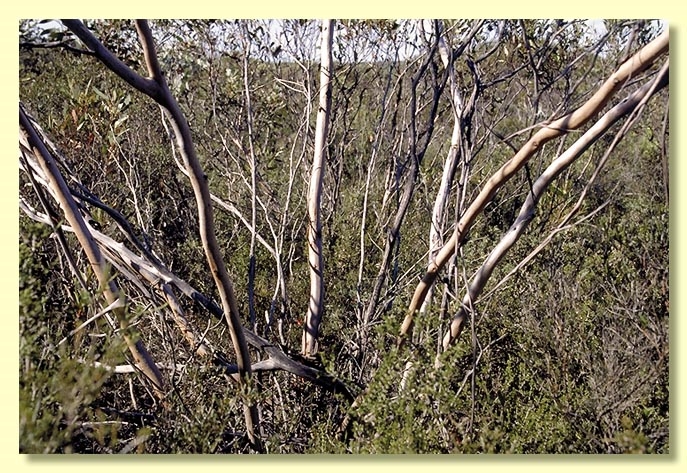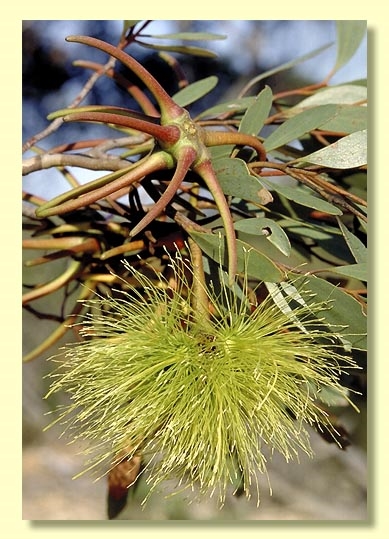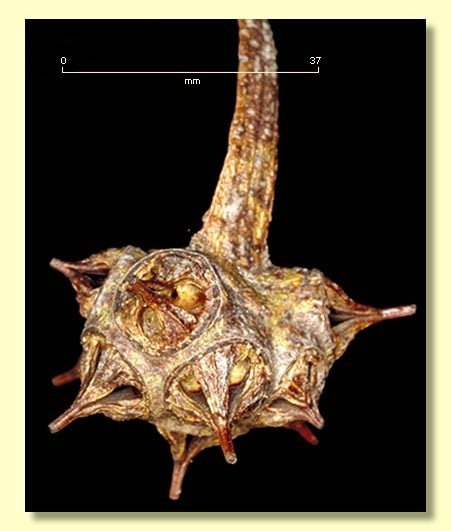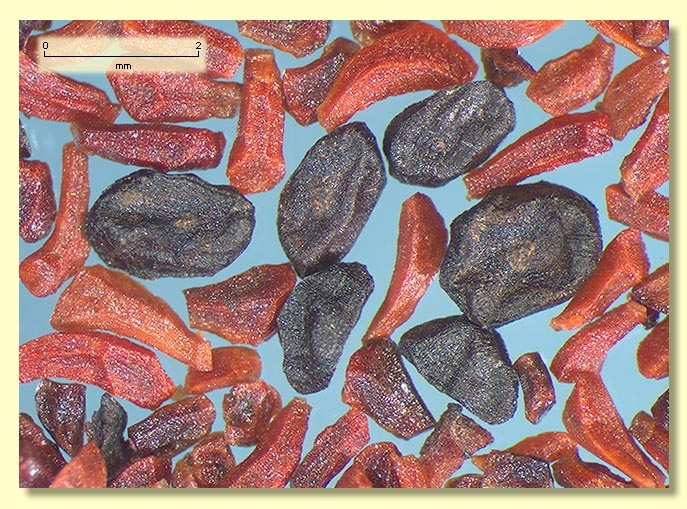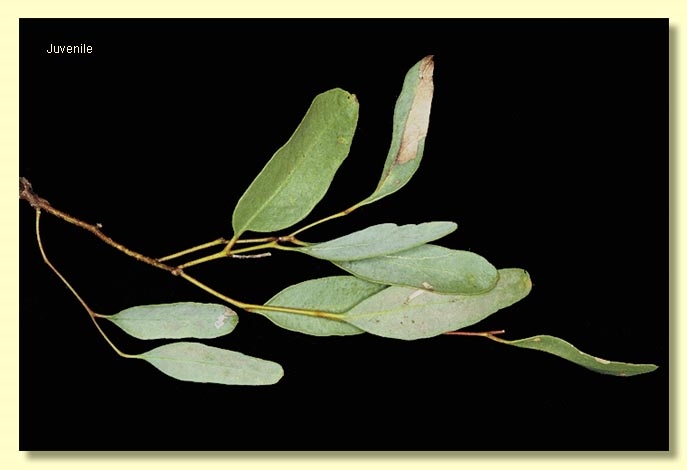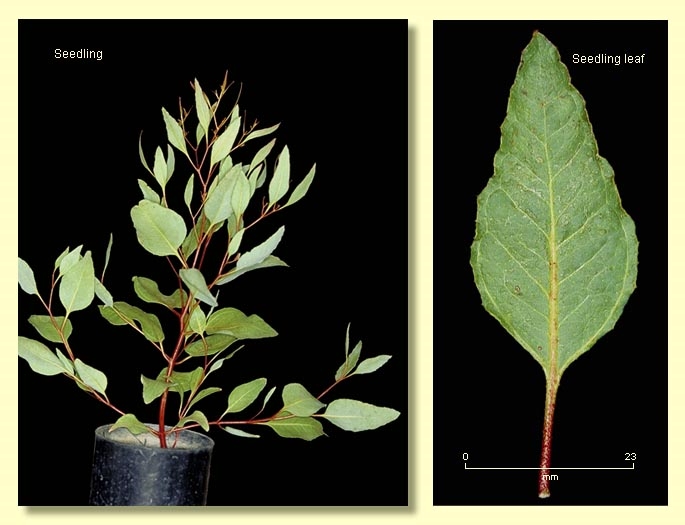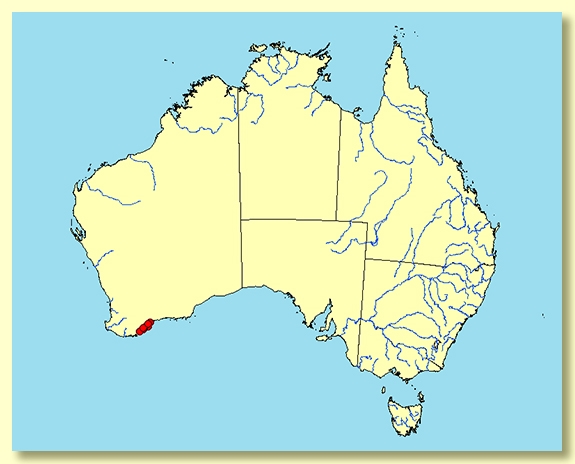Eucalyptus | Symphyomyrtus | Bisectae | Hadrotes | Lehmannianae | Conjunctae
Euclid - Online edition
Eucalyptus lehmannii subsp. lehmannii
Classification
Nomenclature
Eucalyptus lehmannii (Schauer) Benth., Fl. Austral. 3: 233 (1867) subsp. lehmannii
Symphyomyrtus lehmannii Schauer in J.G.C.Lehmann, Pl. Preiss. 1: 127 (1844). T: Cape Riche, W.A., 19 Nov. 1840, L.Preiss 227; lecto: LD n.v., fide D.J.Carr & S.G.M.Carr, Austral. J. Bot. 28: 531 (1980); isolecto: G, MEL.
Symphyomyrtus lehmannii Schauer in J.G.C.Lehmann, Pl. Preiss. 1: 127 (1844). T: Cape Riche, W.A., 19 Nov. 1840, L.Preiss 227; lecto: LD n.v., fide D.J.Carr & S.G.M.Carr, Austral. J. Bot. 28: 531 (1980); isolecto: G, MEL.
Description
Mallee to 5 m tall, stems slender. Forming a lignotuber.
Bark smooth throughout, whitish grey to grey-brown and orange-brown, shedding in strips.
Branchlets lack oil glands in the pith.
Juvenile growth (coppice or field seedlings to 50 cm): stems triangular in cross-section near the growing tips but soon becoming rounded, warty to scabrid on fresh young growth but soon smooth; juvenile leaves always petiolate, alternate, ovate, dimensions unrecorded, lower leaves dull blue-green, upper leaves glossy, green, not scabrid.
Adult leaves alternate, petioles 0.5–1 cm long; blade elliptical to ovate or obovate, 3.5-6.5 cm long, (1.3)1.6-2.7 cm wide, base tapering to petiole, margin entire, apex usually rounded and apiculate, concolorous, glossy often with a glazed sheen, light to mid-green, side-veins at an acute or wider angle to midrib, reticulation usually sparse to moderate, intramarginal vein conspicuous and remote from margin such that sometimes the blade appears to have 3 main veins, oil glands obscure or scattered, intersectional.
Inflorescence axillary unbranched, peduncles flattened and widening apically, down-curved by time of flowering, 3-5.5(8) cm long; buds 7–21(27) per umbel which is syncarpous, pedicels absent. All the buds in an umbel are completely joined by the hypanthium (base) only, the upper part of each bud remains free; at maturity the combined length of the fused part plus operculum is ca 3.3-6.5 cm. Scar left by the early shedding of the outer (sepaline) operculum is often difficult to see; inner (petaline) operculum often slightly curved, 5 to 8 times as long as the fused part of the bud (the inner operculum at maturity is 2.7-5.5 cm long and is widest at its base being 0.5–1 cm); stamens completely erect, anthers narrowly oblong, versatile, dorsifixed, dehiscing by longitudinal slits, style long and straight, stigma blunt, locules 3, the placentae each with 4 vertical rows of ovules. Flowers green-yellow.
Fruit on down-turned peduncles, syncarpous, the individual capsules in the woody mass 0.8–1.3 cm wide, length not measurable, dehiscing by elliptical holes formed as the 3 valves split along the sutures but remain ± connected apically, disc covers the surface of the valves.
Seeds blackish, 1.3–3 mm long, ovoid to more or less angularly so, dorsal surface shallowly reticulate, hilum ventral/terminal.
Cultivated seedlings (measured at node 10): cotyledons Y-shaped (bisected); stems triangular but soon becoming rounded in cross-section, scabrid throughout; leaves always petiolate, opposite ca 4-5 nodes then alternate, ovate-deltoid to ovate, 3–5 cm long, 2–3.5 cm wide, dull grey-green to green, lamina scabrid becoming sparsely so.
Bark smooth throughout, whitish grey to grey-brown and orange-brown, shedding in strips.
Branchlets lack oil glands in the pith.
Juvenile growth (coppice or field seedlings to 50 cm): stems triangular in cross-section near the growing tips but soon becoming rounded, warty to scabrid on fresh young growth but soon smooth; juvenile leaves always petiolate, alternate, ovate, dimensions unrecorded, lower leaves dull blue-green, upper leaves glossy, green, not scabrid.
Adult leaves alternate, petioles 0.5–1 cm long; blade elliptical to ovate or obovate, 3.5-6.5 cm long, (1.3)1.6-2.7 cm wide, base tapering to petiole, margin entire, apex usually rounded and apiculate, concolorous, glossy often with a glazed sheen, light to mid-green, side-veins at an acute or wider angle to midrib, reticulation usually sparse to moderate, intramarginal vein conspicuous and remote from margin such that sometimes the blade appears to have 3 main veins, oil glands obscure or scattered, intersectional.
Inflorescence axillary unbranched, peduncles flattened and widening apically, down-curved by time of flowering, 3-5.5(8) cm long; buds 7–21(27) per umbel which is syncarpous, pedicels absent. All the buds in an umbel are completely joined by the hypanthium (base) only, the upper part of each bud remains free; at maturity the combined length of the fused part plus operculum is ca 3.3-6.5 cm. Scar left by the early shedding of the outer (sepaline) operculum is often difficult to see; inner (petaline) operculum often slightly curved, 5 to 8 times as long as the fused part of the bud (the inner operculum at maturity is 2.7-5.5 cm long and is widest at its base being 0.5–1 cm); stamens completely erect, anthers narrowly oblong, versatile, dorsifixed, dehiscing by longitudinal slits, style long and straight, stigma blunt, locules 3, the placentae each with 4 vertical rows of ovules. Flowers green-yellow.
Fruit on down-turned peduncles, syncarpous, the individual capsules in the woody mass 0.8–1.3 cm wide, length not measurable, dehiscing by elliptical holes formed as the 3 valves split along the sutures but remain ± connected apically, disc covers the surface of the valves.
Seeds blackish, 1.3–3 mm long, ovoid to more or less angularly so, dorsal surface shallowly reticulate, hilum ventral/terminal.
Cultivated seedlings (measured at node 10): cotyledons Y-shaped (bisected); stems triangular but soon becoming rounded in cross-section, scabrid throughout; leaves always petiolate, opposite ca 4-5 nodes then alternate, ovate-deltoid to ovate, 3–5 cm long, 2–3.5 cm wide, dull grey-green to green, lamina scabrid becoming sparsely so.
Flowering Time
Flowering has been recorded in January, February, May, October and November.
Notes
Eucalyptus lehmannii is a small mallee endemic to Western Australia, widespread in southern coastal and subcoastal areas from Manypeaks, Cape Riche and the Stirling Range area eastwards toward Mount Burdett and Condingup east of Esperance. The stems are smooth, the adult leaves glossy green and variable in shape from narrow-lanceolate to shortly elliptic-oblong, often apiculate. The large pendulous bud and fruit clusters are conspicuous in the crown and stamens long green to yellowish.
There are two subspecies:
E. lehmannii subsp. lehmannii has a restricted distribution in the coastal hills from Beaufort Inlet west to Cape Riche. It is distinguished by the shorter, generally broader crown leaves often elliptical in shape and with rounded apex. The leaf length: breadth ratio falls in the range 2.0-3.7.
E. lehmannii subsp. parallela occurs from the Stirling Range and Hamilla Hill east to Corackerup, Jerramungup, the Ravensthrope Range and Fitzgerald River National Park and sporadically further east to Cape Le Grand, Mount Belches, Mount Burdett and Howick Hill. It is distinguished by the linear to lanceolate crown leaves usually with more pointed apex. The leaf length: breadth ratio falls in the range 3.2-9.2.
In the classification of Brooker (2000) Eucalyptus lehmannii belongs in Eucalyptus subgenus Symphyomyrtus section Bisectae subsection Hadrotes because the cotyledons are coarsely bisected, buds have an operculum scar, a long (inner) operculum and erect stamens, fruit are large, thick-rimmed and held rigidly. There are 12 species in subsection Hadrotes, two species (E. macrandra, E. cornuta ) have oil glands in the pith whilst 10 species lack these oil glands. Together these 10 species form series Lehmannianae, a group further characterised by having scabrid seedlings and fruit with exserted valves that remain fused at their tips after seed is shed, a feature shared with the more distantly related E. cornuta.
Of the ten species in series Lehmannianae six species, E. lehmannii, E. conferruminata, E. arborella, E. mcquoidii, E. sinuosa and E. retusa have the buds (and fruit) in each axillary cluster fused basally (subseries Conjunctae) whilst the other four, E. newbeyi, E. burdettiana, E. talyuberlup, and E. megacornuta, have buds and fruit in each umbel basally free (subseries Liberae). The scabridity of the seedling leaves of these ten species is due to emergent multicellular oil glands.
E. lehmannii is distinguished from its closest relative E. arborella by its mallee habit (E. arborella is a mallet and also has broader seedling leaves). Both these species have broadly flattened down-turned peduncles, bud clusters of similar size (up to 21 buds per cluster) and opercula that are very long and slender. The newly described mallee E. sinuosa differs in having narrower adult leaves, terete peduncles and opercula that are longer, sinous and dilated at the end. E. mcquoidii differs in being a non-lignotuberous shrub (marlock) or stunted mallet with terete down-turned peduncles, many more buds per cluster (to ca 50) but with similar graceful slender opercula to E. lehmannii. E. conferruminata is also a marlock or mallet and has flattened down-turned peduncles and similar bud numbers to E. lehmannii, but stout relatively short opercula (< 5 times as long as wide). Another newly described species, the mallee E. retusa, differs from all these species in having short obovate leaves with rounded or emarginate apex, terete peduncles, smaller buds only partially fused basally and shortish narrow straight opercula. All these related species occur partially or completely within the geographic range of E. lehmannii.
Eucalyptus lehmannii is a decorative ornamental mallee in its own right, not to be confused with E. conferruminata which for many years was sold and planted under the name E. lehmannii.
In Victoria Carr et al. (1992) regard this species as an environmental weed with the potential to pose a risk to heath and associated woodlands, and lowland grassland, noting that it is currently rare or localized in small populations.
The mallee E. bennetiae D.J.Carr & S.G.M.Carr is a well-known, naturally occurring hybrid found in the Mount Desmond area near Ravensthorpe and also a little further to the south-east of there. Studies by Byrne & Walker (unpubl. report 2003) showed the parents to be Eucalyptus sporadica and E. lehmannii subsp. parallela, as had been suspected. The progeny (seedlings) of plants of E. bennetiae are known to show morphological segregation reflecting their hybrid origin.
Eucalyptus bennetiae is listed as "Vulnerable" under the Australian Government Environment Protection and Biodiversity Conservation Act 1999 (EPBC Act). Further information may be found at this web address:
http://www.environment.gov.au/cgi-bin/sprat/public/sprat.pl
There are two subspecies:
E. lehmannii subsp. lehmannii has a restricted distribution in the coastal hills from Beaufort Inlet west to Cape Riche. It is distinguished by the shorter, generally broader crown leaves often elliptical in shape and with rounded apex. The leaf length: breadth ratio falls in the range 2.0-3.7.
E. lehmannii subsp. parallela occurs from the Stirling Range and Hamilla Hill east to Corackerup, Jerramungup, the Ravensthrope Range and Fitzgerald River National Park and sporadically further east to Cape Le Grand, Mount Belches, Mount Burdett and Howick Hill. It is distinguished by the linear to lanceolate crown leaves usually with more pointed apex. The leaf length: breadth ratio falls in the range 3.2-9.2.
In the classification of Brooker (2000) Eucalyptus lehmannii belongs in Eucalyptus subgenus Symphyomyrtus section Bisectae subsection Hadrotes because the cotyledons are coarsely bisected, buds have an operculum scar, a long (inner) operculum and erect stamens, fruit are large, thick-rimmed and held rigidly. There are 12 species in subsection Hadrotes, two species (E. macrandra, E. cornuta ) have oil glands in the pith whilst 10 species lack these oil glands. Together these 10 species form series Lehmannianae, a group further characterised by having scabrid seedlings and fruit with exserted valves that remain fused at their tips after seed is shed, a feature shared with the more distantly related E. cornuta.
Of the ten species in series Lehmannianae six species, E. lehmannii, E. conferruminata, E. arborella, E. mcquoidii, E. sinuosa and E. retusa have the buds (and fruit) in each axillary cluster fused basally (subseries Conjunctae) whilst the other four, E. newbeyi, E. burdettiana, E. talyuberlup, and E. megacornuta, have buds and fruit in each umbel basally free (subseries Liberae). The scabridity of the seedling leaves of these ten species is due to emergent multicellular oil glands.
E. lehmannii is distinguished from its closest relative E. arborella by its mallee habit (E. arborella is a mallet and also has broader seedling leaves). Both these species have broadly flattened down-turned peduncles, bud clusters of similar size (up to 21 buds per cluster) and opercula that are very long and slender. The newly described mallee E. sinuosa differs in having narrower adult leaves, terete peduncles and opercula that are longer, sinous and dilated at the end. E. mcquoidii differs in being a non-lignotuberous shrub (marlock) or stunted mallet with terete down-turned peduncles, many more buds per cluster (to ca 50) but with similar graceful slender opercula to E. lehmannii. E. conferruminata is also a marlock or mallet and has flattened down-turned peduncles and similar bud numbers to E. lehmannii, but stout relatively short opercula (< 5 times as long as wide). Another newly described species, the mallee E. retusa, differs from all these species in having short obovate leaves with rounded or emarginate apex, terete peduncles, smaller buds only partially fused basally and shortish narrow straight opercula. All these related species occur partially or completely within the geographic range of E. lehmannii.
Eucalyptus lehmannii is a decorative ornamental mallee in its own right, not to be confused with E. conferruminata which for many years was sold and planted under the name E. lehmannii.
In Victoria Carr et al. (1992) regard this species as an environmental weed with the potential to pose a risk to heath and associated woodlands, and lowland grassland, noting that it is currently rare or localized in small populations.
The mallee E. bennetiae D.J.Carr & S.G.M.Carr is a well-known, naturally occurring hybrid found in the Mount Desmond area near Ravensthorpe and also a little further to the south-east of there. Studies by Byrne & Walker (unpubl. report 2003) showed the parents to be Eucalyptus sporadica and E. lehmannii subsp. parallela, as had been suspected. The progeny (seedlings) of plants of E. bennetiae are known to show morphological segregation reflecting their hybrid origin.
Eucalyptus bennetiae is listed as "Vulnerable" under the Australian Government Environment Protection and Biodiversity Conservation Act 1999 (EPBC Act). Further information may be found at this web address:
http://www.environment.gov.au/cgi-bin/sprat/public/sprat.pl
Origin of Name
Eucalyptus lehmannii: after Johan Georg Christian Lehmann (1792–1860). Johan Lehmann was Professor of Botany and Director of the Botanic Gardens in Hamburg, Germany. He was an author of many botanical books.
Copyright © CANBR 2020, all rights reserved.

Web edition hosted at https://apps.lucidcentral.org/euclid

